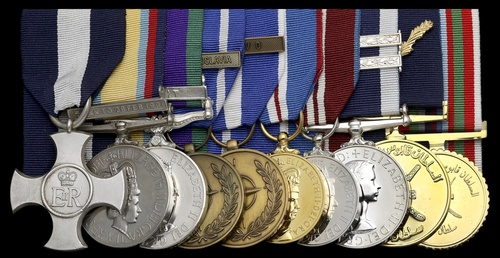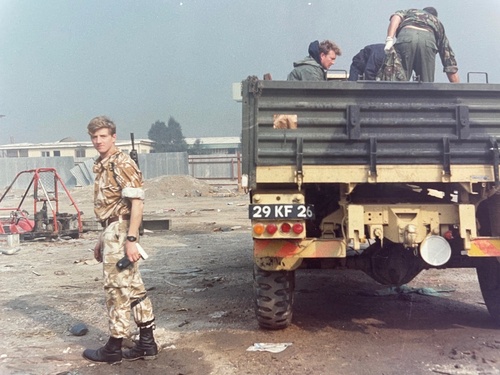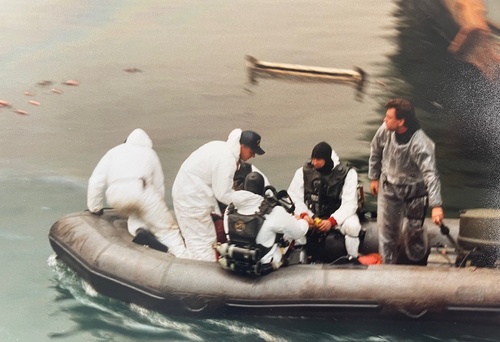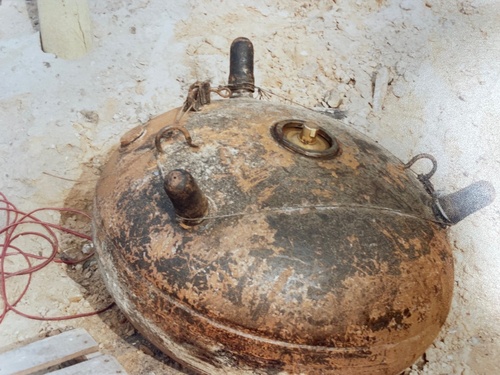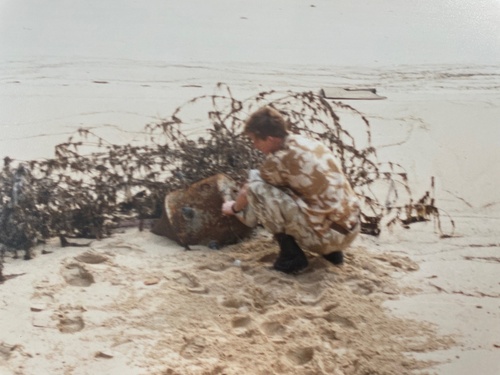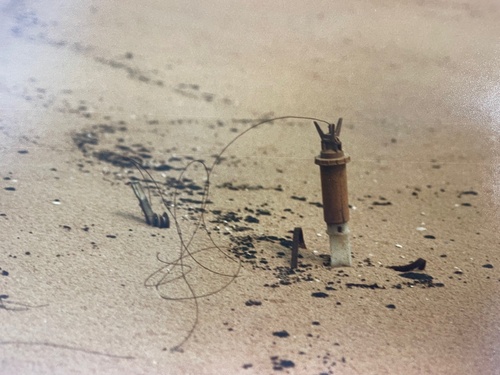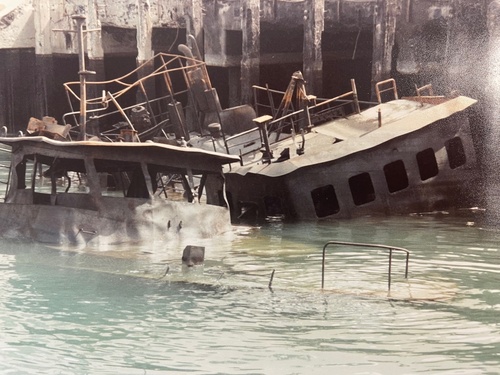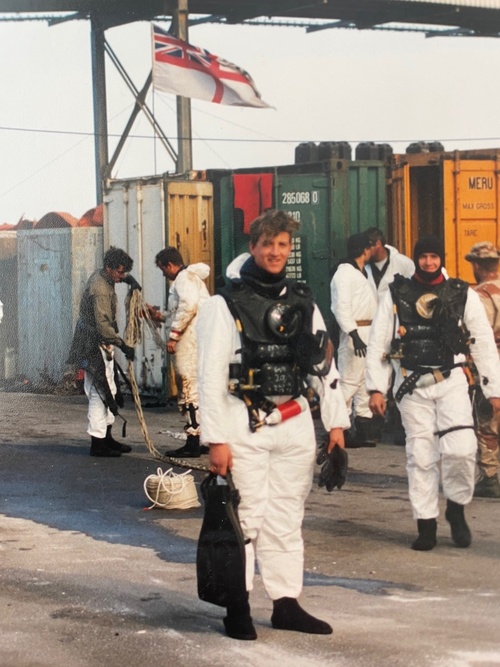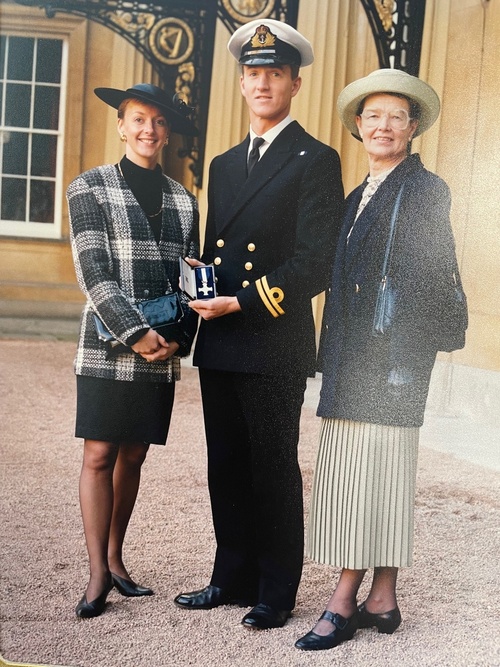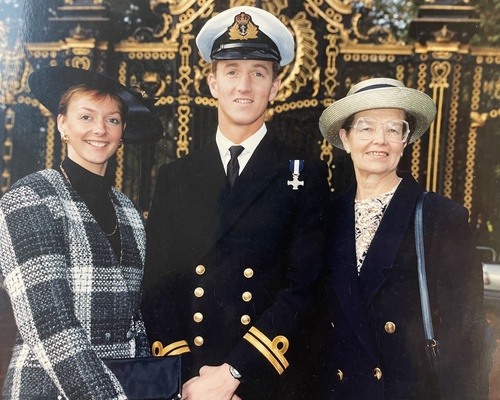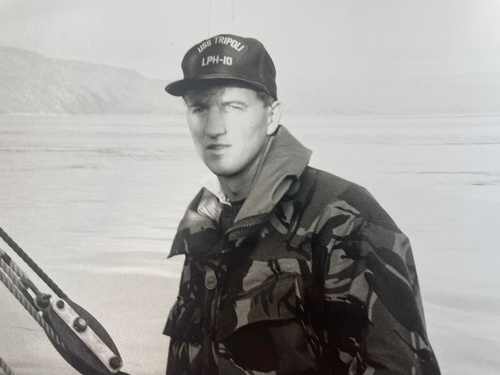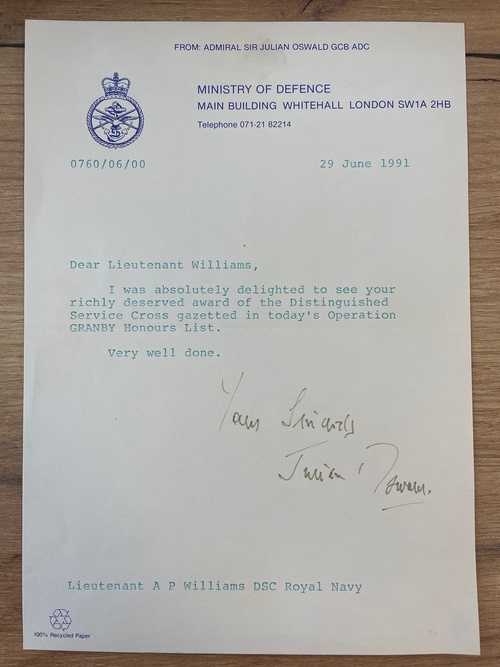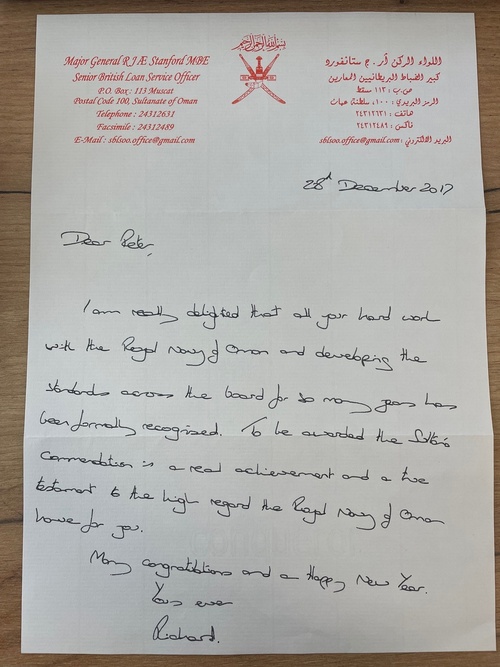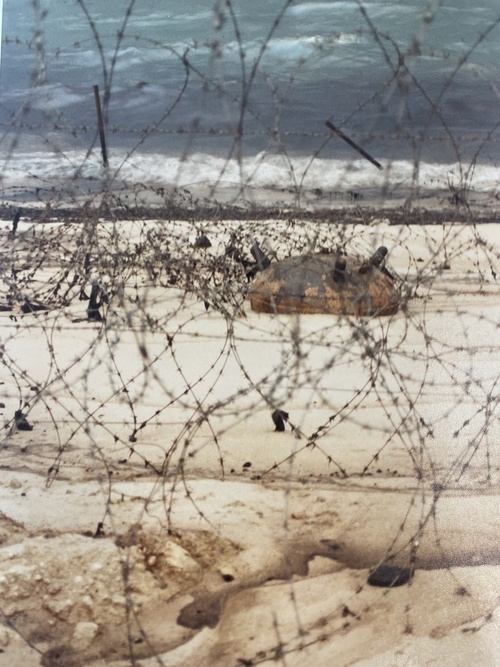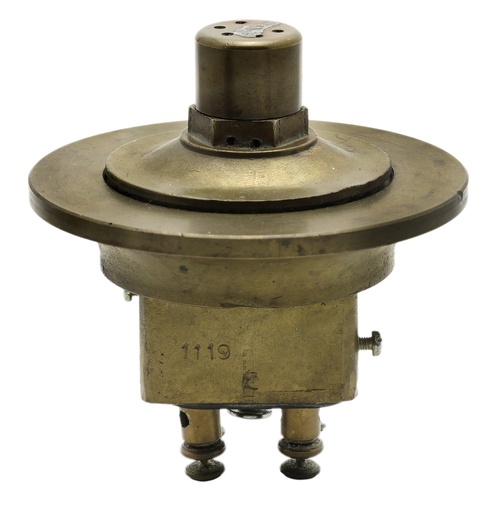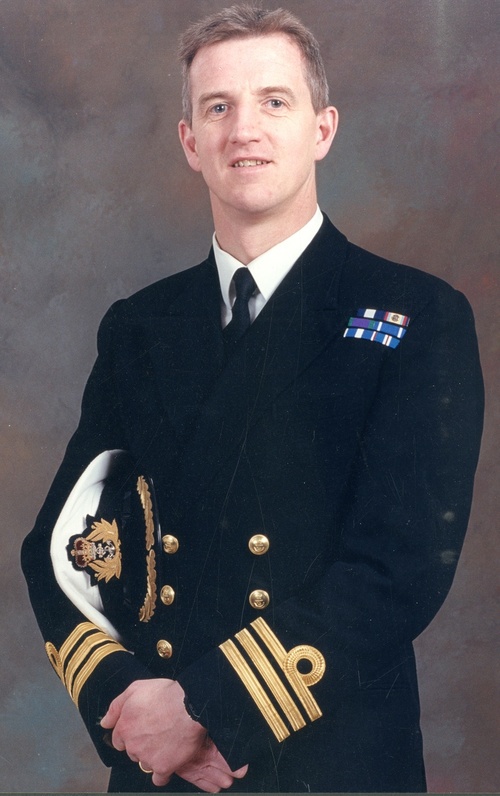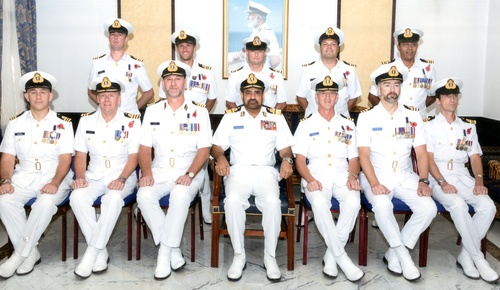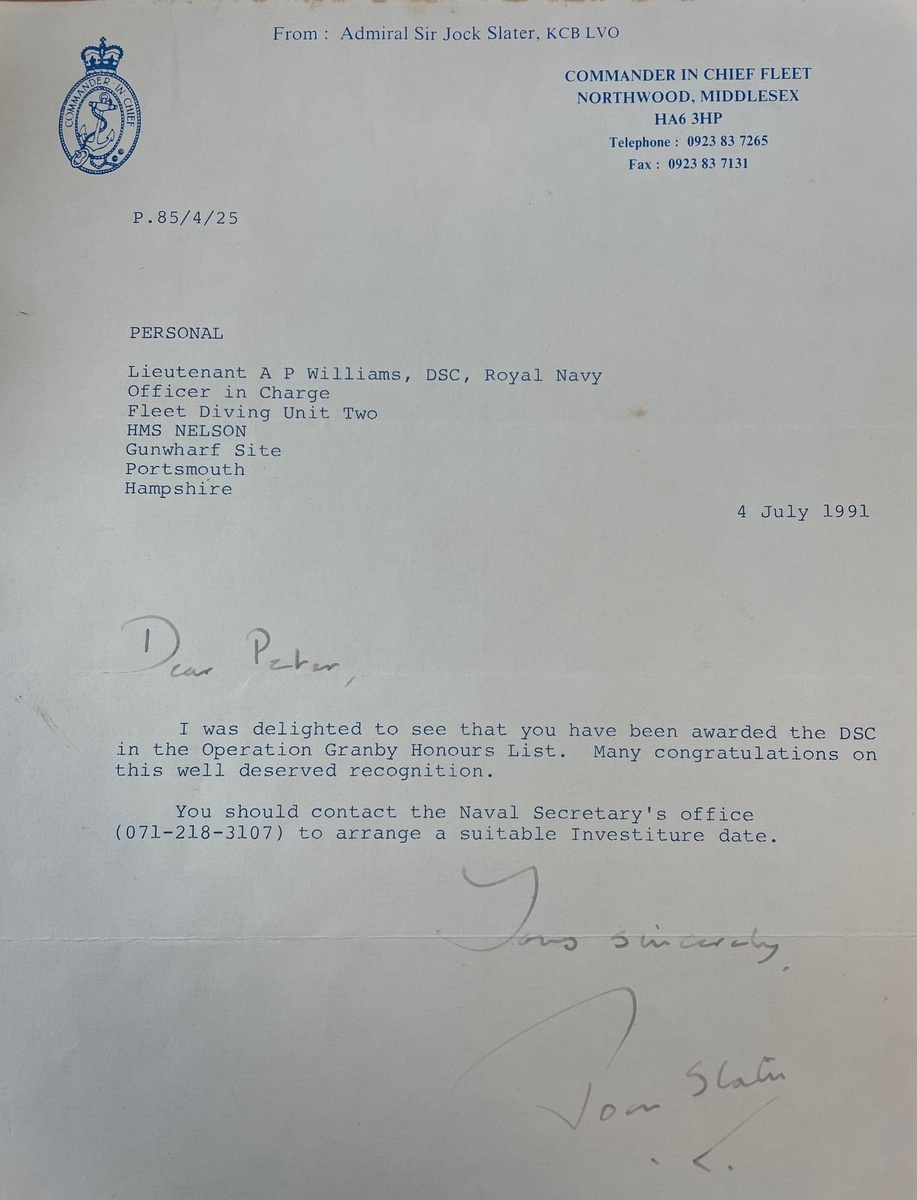Auction: 25001 - Orders, Decorations and Medals
Lot: 310
Sold by Order of the Recipient
'We swing between the steel gates to see sabotaged cranes lying toppled and half-immersed in the foul thickness of what was once water - like the skeletons of prehistoric creatures preserved in their death throes...
Their only light relief is when they are allowed to blow up the massive stocks of light ammunition left behind by fleeing Iraqis...My team is working just inside the main harbour wall; those not diving or supervising are huddled around a brazier in whatever layers of clothing they can fit over their uniform. They look like a group of down-and-outs surviving inner city decay on an English winter's day.
I am met by their CO, Lieutenant Peter Williams, once a carefree Sub Lieutenant with me in Avenger. He now looks drawn and a good deal older - but I dare say so do I. His exploits will rightly win him a Distinguished Service Cross...
I inspect their 'goodies', row upon row of Iraqi ordnance: booby traps extracted from dark corners; abandoned shells and grenades; flares and machine-gun bullet bandoliers and weapon cases. They are all stacked neatly into little symmetrical pyramids along the jetty.'
Captain Craig brings to life the scenes in the Gulf in Call for Fire
An outstanding Gulf War Bomb Disposal 1991 D.S.C. group of twelve awarded to Commander A. P. Williams, Royal Navy, who led Fleet Diving Unit B during Operation 'Granby'
He led 'utterly from the front' with a cool confidence to the task, keeping a detailed - and hitherto unpublished - diary of events during those pivotal days and 'personally led several countermining sorties - by day and night - against some of the 1,500 Iraqi mines' and latterly in the post-War efforts in 'appalling and hazardous conditions to clear the Kuwaiti harbours' - thus adding a scarce 'Kuwait' clasp to his laurels for his work commanding Fleet Diving Unit B & NP1037
Distinguished Service Cross, E.II.R., the reverse engraved 'Lt A P Williams RN', with its Royal Mint case of issue; Gulf 1990-91, 1 clasp, 16 Jan to 28 Feb 1991 (Lt A P Williams RN); General Service 1962-2007, 1 clasp, Kuwait (Lt A P Williams RN); N.A.T.O. Medal, 1 clasp, Former Yugoslavia; N.A.T.O. Medal, 1 clasp, Kosovo; Jubilee 2002; Jubilee 2012; Royal Navy L.S. & G.C., E.II.R., with 2 Additional Service Bars (Lt Cdr A P Williams DSC RN), with the named box of issue; Oman, Sultanate, Sultan's Commendation Medal (Midal ut-Tawsit), with emblem upon riband; 45th Anniversary National Day Medal; Saudia Arabia, Kingdom, Kuwait Liberation Medal; Kuwait, Emirate, Liberation Medal, silver grade, mounted court-style as worn, these last two separately as per Order of Wear, good very fine, in a case used by the recipient, the lid blocked 'Commander Peter Williams DSC' (12)
Approximately 11 D.S.C.s awarded in the post-Second World War era for actions relating to Minewarfare, Diving and EOD work.
Just 7 D.S.C.s awarded for Operation 'Granby'.
D.S.C. London Gazette 29 June 1991:
'Williams arrived in the Northern Arabian Gulf on 1 February 1991 as Deputy Officer in Charge of Fleet Diving Unit B (FDU B). He moved into action immediately, co-ordinating training, refining techniques on new equipment, establishing an Explosive Ordnance Disposal (EOD) cell and overseeing inspections for Improvised Explosive Devices (lEDs) in ships of the RN Task Group as they arrived in Bahrain.
During hostilities Williams was the supervisor of an airborne EOD team and of diving operations from Gemini craft, spending many hours in helicopters in the front line of Naval operations, often within ten miles of the enemy coast. Insisting on putting himself in the way of danger before his men, he showed remarkable courage and stamina by leading personally on countermining sorties, placing charges on live buoyant mines and diving for protracted periods, often at night, on live ground mines in order to bring them to the surface for exploitation. In addition he conducted the unenviable task of recovering dead bodies from the sea into helicopters. He led a team of two men on an inspection of HMS Gloucester to search for a mine reportedly entangled in her propeller shafts.
Moving ashore on 5 March to Mina Ash Shuaybah he took over as Officer In Charge of FDU B. He established a base camp and helped co-ordinate EOD operations with American and Australian Units for clearing the ports of Mina Al Ahmadi, Mina Ad Dohah and Faylakah Island. The work involved rendering safe unstable live ordnance, beached mines, booby traps and lEDs, clearing buildings and oil tankers of ordnance and collecting dead bodies from the harbour waters. Often these jobs required him and his team to first reach the scene through areas of antipersonnel mines and barbed wire. Throughout this extremely dangerous operation he showed an implacable professionalism and positive leadership which was beyond his experience. At all times his men saw him in the leading role, tirelessly taking on the most hazardous tasks himself.
The conditions under which FDU B operated were atrocious. With no infrastructure ashore the men lived in cargo containers on a jetty with no light, sanitation or potable water, in an atmosphere heavy with acrid smoke and toxic fumes from the oilfield fires burning inland, and diving in water with zero visibility due to the thick oil pollution.
All the time they were at risk from random gunfire from uncontrolled factions of the local population. Williams's conspicuous leadership, resolute professionalism and boundless energy ensured that his Unit's effectiveness remained at peak levels from start to finish and that his men's morale was of the highest order in the face of dire adversity.'
Personel Report covering the dates 1 February-23 April 1991, as Officer in Charge Fleet Diving Unit B & NP1037 to Commander Task Group 321.1, from Commodore C. J. S. Craig, Commander Task Group 321.1:
'This is to certify that Lieutenant Williams has conducted himself to my entire satisfaction.
Williams came into theatre after two weeks has elapsed of the Gulf War, becoming Deputy Officer in Charge of a Fleet Diving Unit. Initially a supervisor of the airborne EOD teams, he personally led several countermining sorties - by day and night - against some of the 1500 Iraqi mines.
Shortly after the war finished he took over he took over as the Officer in Charge of the combined diving team which worked for several weeks in appalling and hazardous conditions to clear the main Kuwaiti harbours - a task which was completed ahead of time and thankfully without any casualties. Throughout this period Williams has led courageously, and utterly from the front, has shown stamina, cheerfulness and professionalism, and has set a fine example to his people. He has briefed clearly, shown economical style with his signalled reports and demonstrated an ability to organise events sensibly and wisely.
I have recommended his without reservation for transfer to the General List and would see him developing his professional potential through further command for which I also have recommended him.
Altogether Williams can be extremely proud of his achievements in peace and war in the Gulf.'
Sultan's Commendation Medal citation states:
'Commander Anthony Peter Williams Royal Navy has provided an outstanding contribution to the Royal Navy of Oman having served almost 6 years since he joined on loan service on 29 July 2011. During this period he has worked delivering training to the Navy, initially in Fleet Staff and more recently in the Head of Sea Training department. His primary role is to plan and execute sea training periods for all Royal Navy of Oman Vessels.
Additionally, Commander Williams is the Superintendent of Diving. In this role he has assured the safe working practices of the Royal Navy of Oman's Diving Unit and has been instrumental in scoping the requirement for an improved Mine Countermeasures capability for which he is a trusted advocate. Regularly working in excess of normal hours at sea and in harbour he has devoted himself to the improvement of the Navy's operational effectiveness. At sea he has been a mentor to a generation of Commanding Officers, Executive Officers and Principal Warfare Officers, he has patiently, expertly and with a high degree of professionalism taught them the art and science of running a warship. Every detail is noticed by Williams and he takes pride in helping ships rectify their shortcomings and become better warships.
He has been the catalyst for the procurement of several pieces of equipment, including Line Throwing Devices, Thermal Imaging Cameras, Body Armour and Combat helmets that have contributed significantly to improving operations at sea and in harbour. During Commander Williams 6 year period as the Royal Navy of Oman's Senior Sea Training Officer several new major classes of ships have been procured. Commander Williams expertly lead the planning for, and delivered, training in The Netherlands, Australia and Singapore for these brand new ships ensuring that they were safe and ready in all respects for the passage back to Oman. He also scrutinised the equipment fit most carefully and made numerous suggestions for improvements many of which have been adopted by the Navy.
Thereby increasing the utility of the platforms for the good of the Navy and Oman. An experienced, extremely competent and highly professional Officer, Commander Williams has
dedicated himself to improving the operational capability of the Royal Navy of Oman. He has, through exceptional effort and commitment to the task, succeeded and for this should be commended.'
We shall turn to the recipient - Anthony Peter Williams - for a biography, penned shortly before he retired Lieutenant-Commander in 2018:
'Peter Williams joined the Britannia Royal Naval College on a short career commission in 1981 and, on completion of training, joined Yarnton in Hong Kong. After 15 months in the Far East he returned and completed a Falklands deployment with Aveger before specialising as a Mine Warfare and Clearance Diving Officer in 1986. He served as the Executive Officer of Iveston and Dulverton during the period 1987-1990 which included a full MCM programme and deployments with NATO's Standing Naval Force Channel.
He joined Fleet Diving Unit 2 as the Officer in Charge whilst they were deployed to the Gulf on Operation Granby conducting EOD clearance and mine disposal operations to declare the harbours clear before shipping could re-enter Kuwait. For his work in the Gulf he was awarded the DSC. On return the Unit resumed their responsibilities as the RN's worldwide deep diving and Very Shallow Water Mine Countermeasures (MCM) capability. Having transferred to the General List, he joined Birmingham for Sharp Guard duties in the Adriatic before qualifying as a PWO(A) in 1995 and joining Liverpool. He took over as the Executive Officer of Iron Duke in 1997, enjoying a deployment to the West Indies and the East Coast of the United States. A busy operational and exercise programme ensured a rewarding appointment which concluded with a deployment with Standing NATO Force Mediterranean in the Adriatic in 1999 during operations in support of Kosovo.
He spent a short period as the Executive Officer of Kent as she emerged from build before completing the Advanced Command and Staff Course (ACSC) in 2000 gaining an MA in Defence Studies. Promoted Commander in the same year he headed up the Second Sea Lord's Personnel Liaison Team responsible for information flow on personnel policy. He moved to the MOD in 2002 to work on capability issues in the Directorate of Targeting and Information Operations before assuming Command of the Second MCM Squadron in 2004. He subsequently led MCM On-Call Force deployments to the US and the Arctic Circle, took his Battlestaff to the Five Power Defence Arrangement (FPDA) Exercise Bersama Lima in Singapore, conducted two JMCs and controlled survey ops and Force Protection for the T200 Fleet Review. Maximising his Joint credentials he spent 2 years in PJHQ J7 planning and executing the UK Tier 3 Exercise programme which included delivering Suman Protector 07 for FPDA in Malaysia before culminating with delivery of Exercise Joint Venture 08 in Cyprus which concentrated on a cross-Whitehall approach to conflict resolution. He returned to the Joint Command and Staff College in Dec 08 as a member of the Directing Staff for the ACSC spending 2 years teaching before undertaken a short spell of Arabic training at the Defence School of Languages prior to travelling with his family to Oman. As a member of the Loan Service team he has responsibilities as the Fleet Sea Training Officer and a Fleet Staff Officer responsible for maintaining high levels of Operational Capability within the RNO Fleet, whilst he is also leading implementation of an MCM Capability and fulfilling the role of Superintendent of Diving.
Settled in Alresford, near Winchester, two young girls occupy most of spare time but he maintains a hold on reality with a passion for fast motorbikes and a keen interest in swimming and general fitness training to keep a grip on his youth! In his final job in the RN he also has an eye on the future and is looking forward to a financially rewarding career in the commercial marketplace - inshallah!'
It is no surprise he has held the position as UK Manager of the Japanese Shipowners' Association since April 2020.
Further scene-setting of the conditions they operated in can be found in the pages of Call to Fire - Sea Combat in the Falklands and Gulf War by Captain Chris Craig:
'And then we are through the worst, back on to the battered highway, with the air still chill and foul but visibility improved, the motorway signs directing us on to the port of Shuaybah.
We swing between the steel gates to see sabotaged cranes lying toppled and half-immersed in the foul thickness of what was once water - like the skeletons of prehistoric creatures preserved in their death throes. No doors and windows have survived in the administrative buildings, and glutinous hooked fingers of flotsam gleam blackly in the docks and basins of the harbour.
Our divers have transferred ashore to work with the American and Australian divers, living out of shipping containers on the docks in Shuaybah Port, shrouded in the icy gloom. Their only light relief is when they are allowed to blow up the massive stocks of light ammunition left behind by fleeing Iraqis. By the time the detachments return to the UK on 23 April, they will have counter-mined or made safe forty mines.
My team is working just inside the main harbour wall; those not diving or supervising are huddled around a brazier in whatever layers of clothing they can fit over their uniform. They look like a group of down-and-outs surviving inner city decay on an English winter's day. I am met by their CO, Lieutenant Peter Williams, once a carefree Sub Lieutenant with me in Avenger. He now looks drawn and a good deal older - but I dare say so do I. His exploits will rightly win him a Distinguished Service Cross.
The temperature should be 30 centigrade but is less than half that as I join the fireside circle, wishing I had brought something more substantial than my thin action working uniform - and something equally substantial in a bottle. I inspect their 'goodies', row upon row of Iraqi ordnance: booby traps extracted from dark corners; abandoned shells and grenades; flares and machine-gun bullet bandoliers and weapon cases. They are all stacked neatly into little symmetrical pyramids along the jetty.
'What visibility distance have you got down there?' I enquire of a recently surfaced diver as I gesture out across the glutinous basin. The response is succinct: 'What visibility, sir?'
He has just dived beneath the gun emplacements that were attacked by Coalition aircraft. Feeling his way along the foul slime of the harbour bottom, he found himself embracing a tumescent, bloated Iraqi corpse which disintegrated beneath his grasp. A report comes in that a Sergeant on the US clearance team has just lost his hand in an explosion whilst working the adjacent shallows. The cheerful banter of the team, though welcoming, leaves me marooned in introspective reflection. I stare morosely through the harbour entrance. Curving ribbons of contamination ripple away out to sea, to where our ships are just visible, working their way towards us through the mines, and re-opening Kuwait to prosperity. The symbolic first entry by a British minehunter is only days away, but there are four more major ports still to be cleared by this weary team.
I suck despondently at the thin air, still rancid with burnt oil. Bodies, blazing wells, desecrated buildings, burnt-out trucks, charred flesh, tragedy - it is a maimed country. I shiver as again I taste the fruits of victory, with their familiar bitterness. All the glory fades and all the vigour drains. I am intensely weary.'
Sold together with an archive of original material comprising:
i)
His diary for 1991, covering the entire deployment to the Gulf, with detailed descriptions of his exploits, a detailed and most valuable first-hand account of this campaign.
ii)
Section of one of the scores of LUGM-145 sea mines rendered safe by Williams.
iii)
Series of letters and photographs related to the award of his D.S.C. and Omani Medal, besides the aforementioned Conduct Report from Commodore Craig.
iv)
Two personal photograph albums, with a plethora of scenes of the campaign.
v)
Certificates for both N.A.T.O. awards.
v)i
Riband bar, Operation Desert Storm cloth patch and copy of Call to Fire.
Subject to 20% VAT on Buyer’s Premium. For more information please view Terms and Conditions for Buyers.
Estimate
£24,000 to £28,000
Starting price
£22000

